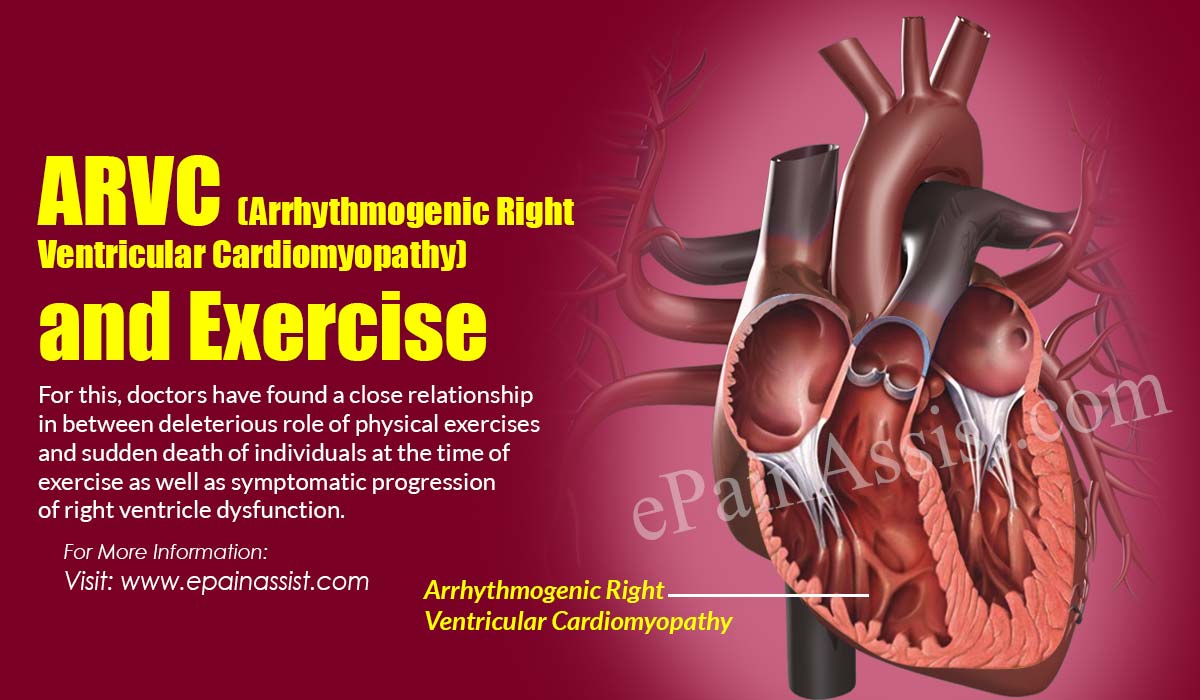ARVC (Arrhythmogenic Right Ventricular Cardiomyopathy) and Exercise
ARVC is the abbreviated form of Arrhythmogenic right ventricular cardiomyopathy and it indicates a genetic cardiomyopathy characterizes sudden death of a person associated with recurrent ventricular arrhythmias and dysfunction of right ventricle of a person, even though the dysfunction of isolated left ventricular may even remain present.

Is Exercise Safe or Not for ARVC (Arrhythmogenic Right Ventricular Cardiomyopathy) Patients?
Most of the patients diagnosed with ARVC ask a common question whether they can involve in any physical exercise or not.
Exercises Provoke Arrhythmias in Patients
For this, doctors have found a close relationship in between deleterious role of physical exercises and sudden death of individuals at the time of exercise as well as symptomatic progression of right ventricle dysfunction. For a majority of patients, exercise provokes the problem of arrhythmias.
Hemodynamic Influence of Physical Exercise
Cardiologists conducted a study of various athletes to demonstrate the hemodynamic influence of physical exercise in ARVC patients. The report highlighted that shear stress of right ventricle increased by about 125 percent with strenuous physical exercise on a prolong basis than only 14% on the left one. With the increase in stretch on thin walls of the right ventricle, effect of physical exercise in ARVC patients result in promoting breakdown of desmosomes, which trigger the replacement of fibrofatty components in RV walls eventually.
Other Relevant Data on Adverse Effect of Exercise in ARVC Patients
American Cardiology College and American Heart Association had released an updated consensus statement about the participation in competitive sports in the year 2005. According to this statement, individuals with a borderline, definite or possible ARVC diagnosis has class III indication in case of participating in any competitive sport based on increase in prevalence of heart failure and ventricular arrhythmias with various high-level athletics. However, there is no or very low indication in case of low intensity type or Class 1A sport, like bowling, billiards and golf.
Another statement associated with International Task Force Consensus about ARVC Treatment has started in the year 2015. This statement gave class IIa recommendation for definite ARVC patients to restrain from any athletic activity beyond any low-intensity type of recreational sports. In addition, the report has also given a class IIa recommendation in case of possible ARVC individuals to avoid involving in any competitive sport.
Identifiable Risk Factors
Research related to ARVC and physical exercise will continue to solidify the advice related to exercise to individuals and family members affected from ARVC. However, medical experts and cardiologists have found digenic and compound heterozygosity associated with desmosomal mutations, biventricular dysfunction, male gender and non-sustained type of ventricular tachycardia as few common identified risk factors related to adverse events stratifying individuals to restrict from doing any physical activity.
Comparison showed Attenuated RV Function among ARVC Patients
Athletes and other individuals possessing normal resting echocardiogram, but with the problem of right ventricle-based ventricular arrhythmias is comparable with healthy endurance athletes as well as non-athletes after their physical workout sessions. The group experiencing ventricular arrhythmias or the problem of ARVC had shown attenuated RV function significantly in response to physical exercise suggestive to subclinical disease.
Hence, with further relevant data, doctors and cardiologists, along with other research professionals will enhance the risk stratification in case of arrhythmogenic right ventricular cardiomyopathy patients to help in guiding the valuable exercise recommendations as well as follow-up in a personalized manner, whether it is of individuals with asymptomatic or symptomatic genetic carriers or ARVC.
Conclusion
A large number of doctors’ panels have discouraged the participation of individuals in any moderate and/or high-intensity type of recreational sport. On the other side, recommendations related to restriction of physical activity in various asymptomatic type of genetic carrier have relatively less data. Hence, if these patients continue with physical activities, they should undergo with regular follow-up from doctors and regular cardiac imaging as well as ECG test evaluation procedure.
Also Read:
- Cardiomyopathy – Causes, Symptoms, Diagnosis, Treatment
- Causes & Symptoms of Arrhythmogenic Right Ventricular Cardiomyopathy or ARVC
- Arrhythmogenic Right Ventricular Cardiomyopathy or ARVC: Treatment, Prognosis, Coping, Complications
- What is the Life Expectancy Of A Woman Who Has Cardiomyopathy?
- What is the life expectancy of someone with hypertrophic cardiomyopathy
- How Long Does A Person live After Being Diagnosed With Cardiomyopathy?
- Can Cardiomyopathy Go Away On It’s Own?
